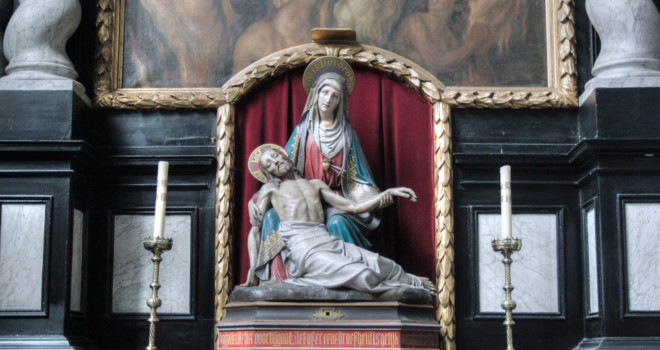“O divine Savior, it was not your purpose to console [Mary] as much as it was to make her grief immortal. She was accustomed to loving God and now found in his place only a mortal man, and she was well aware of the difference.”
– Jacques-Benigne Bossuet, Meditations on Mary, p. 99
As a child, Mary was always a distant mother figure to me. Because of her perfection in virtue and the Immaculate Conception, I couldn’t relate to her. My struggles seemed so far removed from her life. I always pictured her docility, her meekness and patience, and her humility. Imagining the Holy Family with their quiet days and evenings, it just wasn’t relevant to my life.
Then I became a mother. Motherhood has changed me in countless ways, but there is one significant way in which Mary has truly become My Lady, My Mother, and so dear to me. It is in understanding more deeply about her suffering.
The White Martyrdom of Mary
During Lent, we often focus on the Passion of Christ, and rightly so. But do we realize that absolutely everything He experienced was concurrently suffered in the heart of His Mother? Jesus suffered a literal death that day, but Our Lady underwent a white martyrdom — a martyrdom of the heart.
It is widely accepted by most Mariologists that the Blessed Virgin did not experience the pangs of childbirth, nor did she struggle with any sort of pain in her death. But she was not spared from the most horrific heartaches and crosses. The Cross of her Son was her cross, too. Grief pierced her heart the instant Simeon prophesied about Jesus being a contradiction in the world Who would cause the rise and fall of many who would oppose Him.
From that moment onward, Our Lady was given her own passion, which was not lifted from her heart until she was assumed into heaven body and soul. At the foot of the Cross, when Jesus said, “Behold your son,” she knew her suffering was being transferred from experiencing the affliction of her Divine Son to bearing the grief of mortal man who was riddled with sin.
The Three Types of Afflictions We Experience
Bishop Jacques-Benigne Bossuet, a gifted spiritual writer of the nineteenth century, shared in his classic, Meditations on Mary, a beautiful reflection about what we can learn from the Blessed Virgin’s ongoing suffering. He claims there are three types of afflictions we also experience and how God works on our souls to come to perfect peace in each situation:
1. Sorrow is entirely dismissed.
In this case, Fr. Bossuet explained that “the passion is entirely appeased, and we are consoled” (p. 89). It is as if our grief is somehow taken away altogether, which is an incredible grace. Some of us may understand this, while others have not experienced this at all. It is a rare supernatural grace, for which we should be grateful, should it happen upon us.
God allows our souls in this case to experience perfect peace, because He has removed all sorrow. Perhaps the Blessed Mother received this consolation herself, but it is more likely that her own passion existed because she chose it out of love for God.
2. The soul is troubled by evil but bears it patiently.
Fr. Bossuet wrote that the soul in this condition is still aware of the sorrow and grief but has come to a place of resignation. Here is where we may wrestle with our crosses, perhaps out of fear or disdain for suffering. According to Fr. Bossuet, it’s important for us to remain at peace and not give in to the agitation we may feel.
The Blessed Mother’s peace was never disturbed, regardless of her afflictions and troubles – even when she told Jesus after searching for Him for three days that “your father and I have been searching for you with great anxiety.” Her anxiety was not the worry we feel. It was more a concern at not knowing where Jesus was; still, she was not interiorly disturbed.
3. We are aware of the suffering but not troubled by it.
The third level of affliction is when we are both aware of our suffering but are not at all troubled by it. At this point, it seems that God has granted specific graces of “illumination” so that He “gives us great strength,” though we still “suffer its violence, but our peace of soul is not lost” (p. 89).
Imagine, during your own Lenten journey, that the Blessed Mother walks with you as you follow Jesus on Calvary. Your heart, like hers, may be pierced with a thousand pains and agonies, but you beg her intercession to permeate your soul with still more graces that will leave you calm and without tumult as you experience this suffering for love of God.
✠
image: akturer / Shutterstock.com















